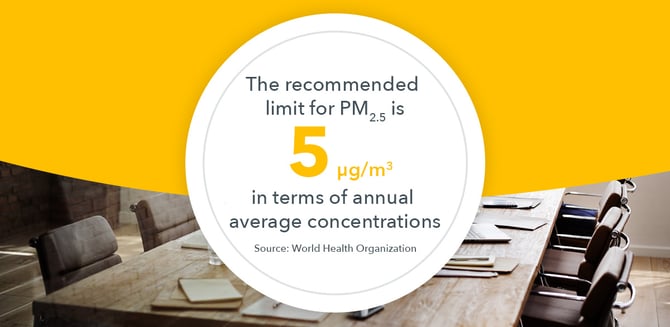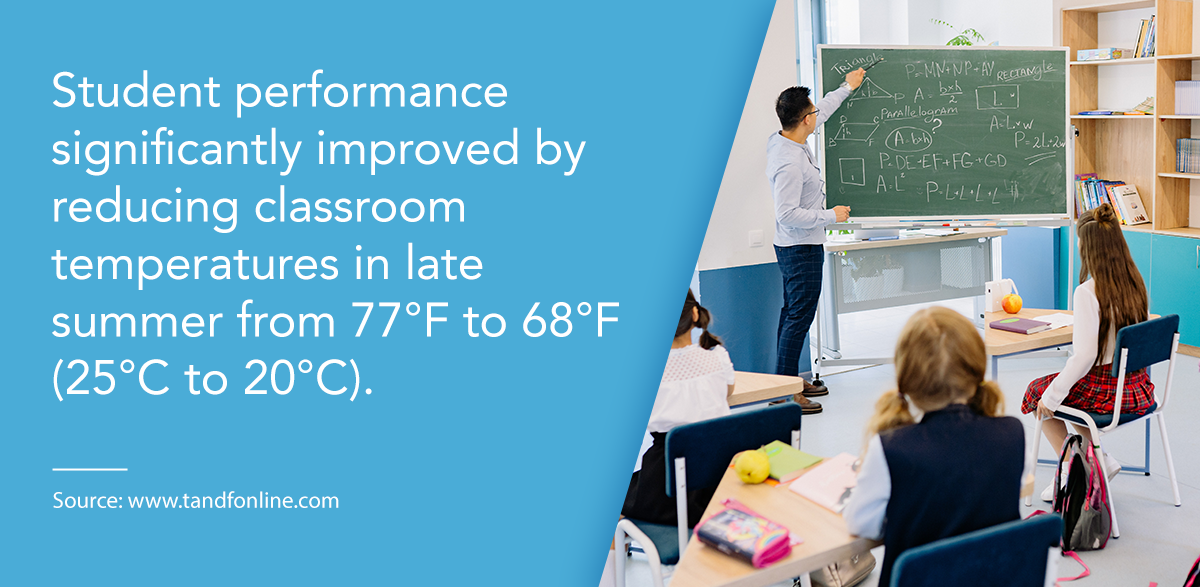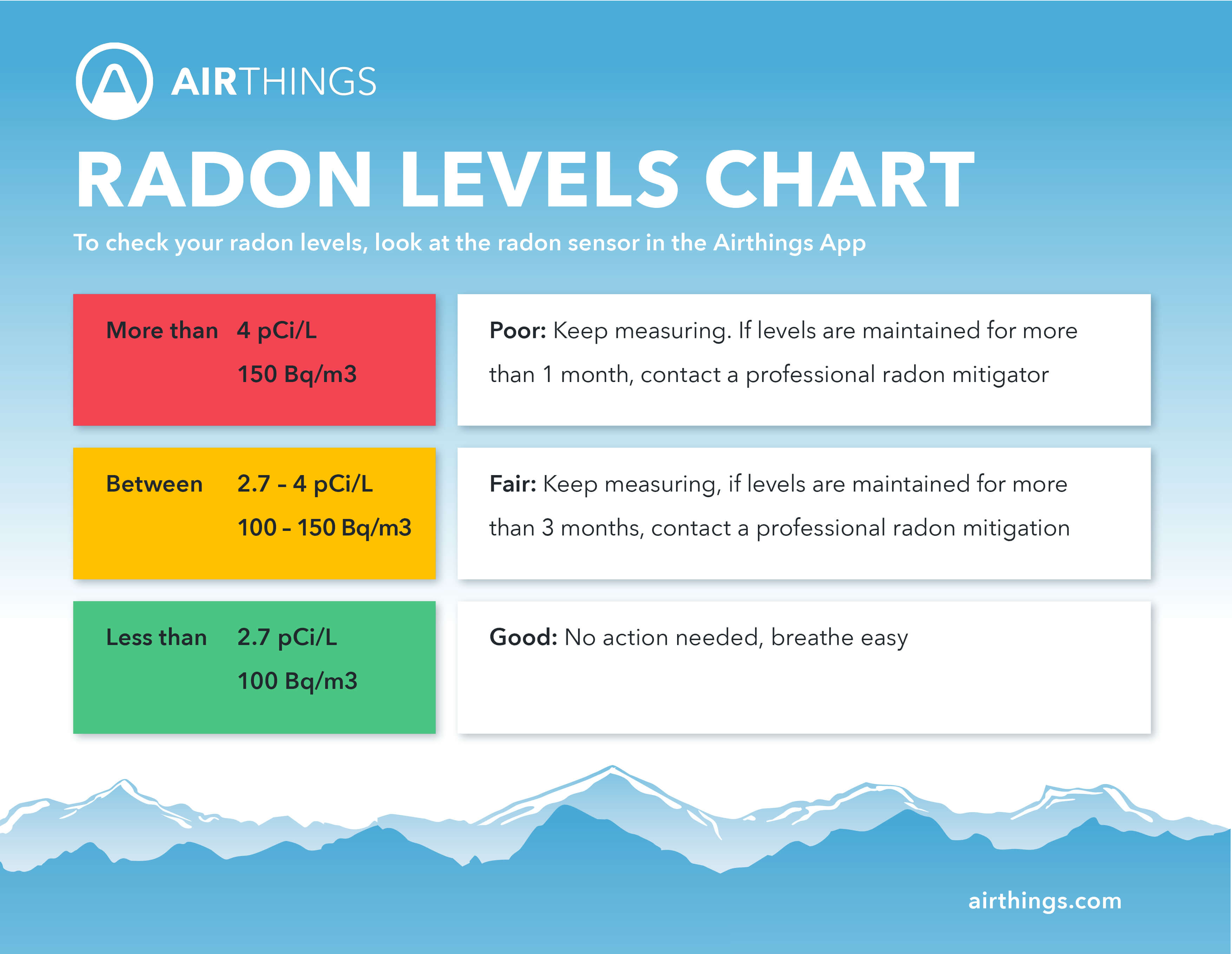A complete, easy guide to ideal air quality levels within buildings.
Indoor air quality has an enormous effect on people's well-being and productivity. For example, did you know that a healthier work environment can reduce sick leave by 58%?1 On top of that, buildings are responsible for 40% of global energy consumption and 33% of greenhouse gas emissions.2
In this article:
What are the optimal carbon dioxide (CO2) levels in a building?
Keep CO2 levels below 800 ppm to ensure good cognitive performance.
Most researchers agree that in places like offices, carbon dioxide levels that are below 800 ppm are considered ideal.3 If indoor concentrations begin to exceed 1000 ppm, people’s decision-making performance is likely to worsen4 by at least 50%.5
Why does it matter?
Decision-making is an essential part of business. With high levels of CO2 in the workplace, workers are slower to respond to daily challenges, which greatly reduces productivity. It also means virus transmission is more likely due to a lack of fresh oxygen.
What is the optimal particulate matter (PM) in a building?
Keep PM2.5 levels below an annual average of 5 µg/m3 to protect occupants from frequent asthma attacks.
Like radon, there are no ‘optimal’ levels for particulate matter. However, in 2021 the World Health Organization did update its guidelines on this pollutant.6 Now, the recommended limit for PM2.5 is 5 µg/m3 in terms of annual average concentrations. Average 24-hour exposure should not exceed 15 µg/m3 for more than three to four days a year.

Why does it matter?
Particulate matter is especially harmful to occupants with breathing difficulties, such as asthma. Monitoring PM levels and taking action when necessary will help businesses actively demonstrate that they care about this issue, boosting staff morale in the process.
What is the optimal temperature in a building?
Set the temperature to around 71.6°F (21°C) to improve workplace concentration and save on energy costs.
Even though personal preferences do vary, a 2014 study concluded that indoor workers make fewer mistakes when the temperature is set to 71.6°F.7
However, keep in mind that the exact ideal temperature will depend on your location and the season—in fact, one study has shown that by reducing classroom temperatures in late summer from 77°F to 68°F (25 °C to 20 °C), the performance of students significantly improved.8
As long as you don’t deviate too far from 71.6°F, you can ensure thermal comfort for your occupants.

Why does it matter?
The temperature of a building has a clear effect on how comfortable occupants feel when performing tasks, which has a knock-on effect on their ability to concentrate and collaborate with one another.9 What’s more, sticking to a moderate temperature will help businesses save on energy bills.
What are the optimal humidity levels in a building?
Keep humidity levels between approximately 40-60% to prevent mold and the spread of infections.
Indoor environments with a humidity level of below 30%-40% make the spread of infections more likely.10 However, if the level exceeds 70%, mold and other fungi are likely to grow.11
Why does it matter?
The higher transmission rate of infections means that occupants have to take sick leave days more often. Mold, on the other hand, damages your building’s structure and can make your facilities uninhabitable. Both issues can severely disrupt business operations.
What is the optimal level of airborne chemicals (VOCs) in a building?
Keep airborne chemical levels between 0-250 ppb to improve overall building satisfaction.
Airborne chemicals (VOCs) consist of many substances of varying toxicity. However, there should be less than 250 ppb of any one chemical in an average indoor environment.12
Why does it matter?
Airborne chemicals can cause eyes, nose, and throat irritation. This can cause occupants to become less satisfied with their building, which can decrease its property value. They even made a name for this phenomenon–sick building syndrome.13

What is the optimal virus risk indicator reading for a building?
Make sure your virus risk level is below 5.
Airthings for Business indoor air quality monitors have a Virus Risk Indicator which ranks your risk level from 1-10. Levels below 5 mean no mitigation is needed.
Why does it matter?
Having a low virus indicator reading helps you put occupants at ease. This is especially important in light of the pandemic, as people are more likely to be anxious about public spaces.
What are the optimal radon levels in a building?
Keep radon levels below 100 Bq/m3 to minimize lung cancer risks.
With radon, there is no set ‘optimal’ level (the lower the measurement, the lower the risk). Still, the World Health Organization states that levels below 100 Bq/m3 or 2.7 pCi/L are not a cause for concern.14
Why does it matter?
Ensuring that your building does not trap excess radon is key to ensuring safety for all occupants and visitors. In some countries, doing so will even help you stay compliant with government regulations.15

What is the optimal air pressure for a building?
There is no specific ideal air pressure level for buildings. In some industrial and laboratory settings, air pressure may help technicians operate machinery more accurately, but the ideal measurement will depend on the context.
What is the optimal differential pressure level for a building?
Keep a negative pressure differential of 2.5-20 Pa to prevent the spread of pathogens.
In U.S. hospital settings, rooms that contain patients with infectious diseases must have a negative pressure differential of at least 2.5 Pa.16
Why does it matter?
Hospitals are legally required to keep some rooms under negative pressure, so contaminated air does not leak into uncontaminated areas.
What is the optimal light intensity level in a building?
Keep light intensity at 500 lux to ensure occupants’ comfort.
According to the US Department of Labor’s OSHA Workplace Lighting Guidelines, lighting in office spaces should typically be 500 lux.17 This is also the recommendation in the United Kingdom for paper-based tasks.18 In other countries or fields of work, recommendations may vary.
Why does it matter?
All commercial buildings should be sufficiently lighted. Not doing so can cause eye strain, fatigue, and headaches. All of these conditions negatively impact health and well-being.
What are the optimal noise levels in a building?
Keep background noise levels below 35 dB(A) to maximize productivity.
According to the World Health Organization, clear speech perception is only possible if background noises do not exceed 35 dB(A).19
Why does it matter?
Background noise can be extremely distracting to building occupants. It also hinders communication and collaboration between employees.
Optimal air quality levels: quick cheat sheet
- Carbon dioxide: Below 800 ppm
- Particulate matter (PM): Below 5 µg/m3 (annual average)
- Temperature: 71.6°F (21°C)
- Humidity: 40-60%
- Airborne chemicals (VOCs): 0-250 ppb
- Virus risk indicator reading: Below 5
- Mold risk indicator reading: Below 4
- Radon: Below 100 Bq/m3 or 2.7 pCi/L
- Differential pressure: 2.5-20 Pa
- Light intensity: 500 lux
- Noise: Below 35 dB(A)

Sources:
1. https://worldgbc.org/news-media/doing-right-planet-and-people-business-case-health-and-wellbeing-green-building
2. https://www.weforum.org/agenda/2021/02/why-the-buildings-of-the-future-are-key-to-an-efficient-energy-ecosystem/
3. https://www.energy.wsu.edu/documents/co2inbuildings.pdf
4. https://www.ncbi.nlm.nih.gov/pmc/articles/PMC3548274/
5. https://dash.harvard.edu/bitstream/handle/1/27662232/4892924.pdf?sequence=1
6. https://www.who.int/publications/i/item/9789240034228?ua=1
7. https://www.ncbi.nlm.nih.gov/pmc/articles/PMC4591743/
8. https://www.tandfonline.com/doi/abs/10.1080/10789669.2007.10390951
9. https://www.bbc.com/worklife/article/20160617-the-never-ending-battle-over-the-best-office-temperature
10. https://www.sciencedaily.com/releases/2013/02/130227183456.htm
11. https://www.epa.gov/indoor-air-quality-iaq/indoor-air-quality-and-energy-efficiency
12. https://www.worldgbc.org/sites/default/files/bp-resource/BPFP-IEQ-Guidance-Note.pdf
13. https://blog.breezometer.com/sick-building-syndrome-will-be-taken-more-seriously-post-pandemic
14. https://www.who.int/news-room/fact-sheets/detail/radon-and-health
15. https://www.radonassociation.co.uk/guide-to-radon/information-for-employers/
16. https://pubmed.ncbi.nlm.nih.gov/20864218/
17. https://www.osha.gov/etools/computer-workstations/workstation-environment
18. https://warwick.ac.uk/services/healthsafetywellbeing/guidance/officelighting/
19. https://www.who.int/docstore/peh/noise/Comnoise-1.pdf
 Most popular
Most popular

 Radon
Radon



 Radon
Radon
 Radon
Radon







